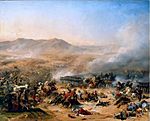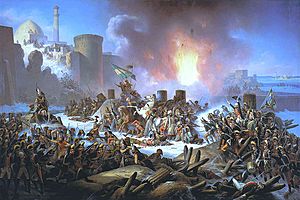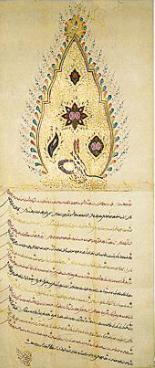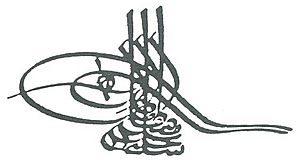Selim III facts for kids
Quick facts for kids Selim III |
|||||
|---|---|---|---|---|---|
| Ottoman Caliph Amir al-Mu'minin Custodian of the Two Holy Mosques Sultan of the two lands, Khagan of the two seas |
|||||

Portrait by Konstantin Kapıdağlı, 1803
|
|||||
| Sultan of the Ottoman Empire (Padishah) | |||||
| Reign | 7 April 1789 – 29 May 1807 | ||||
| Predecessor | Abdul Hamid I | ||||
| Successor | Mustafa IV | ||||
| Born | 24 December 1761 Topkapı Palace, Constantinople, Ottoman Empire |
||||
| Died | 28 July 1808 (aged 46) Topkapı Palace, Constantinople, Ottoman Empire |
||||
| Burial | Laleli Mosque, Istanbul | ||||
| Consorts |
|
||||
|
|||||
| Dynasty | Ottoman | ||||
| Father | Mustafa III | ||||
| Mother | Mihrişah Sultan | ||||
| Religion | Sunni Islam | ||||
| Tughra |  |
||||
Selim III (Ottoman Turkish: سليم ثالث, romanized: Selim-i sâlis; Turkish: III. Selim; 24 December 1761 – 28 July 1808) was the Sultan of the Ottoman Empire from 1789 to 1807. He was seen as a leader who wanted to make his country better. However, a group of soldiers called the Janissaries removed him from power. They put his cousin Mustafa on the throne as Mustafa IV. Selim was later killed by a group of attackers.
Contents
Early Life
Selim III was the son of Sultan Mustafa III and his wife Mihrişah Sultan. His mother, Mihrişah Sultan, was from Georgia. When she became the Valide Sultan (mother of the Sultan), she helped improve government schools. She also helped set up political groups.
His father, Sultan Mustafa III, was very educated. He believed the country needed many changes. Mustafa III tried to build a strong army during peacetime. He wanted professional and well-trained soldiers. He was worried about a Russian invasion. He died in 1774 during a war with Russia. Sultan Mustafa knew that the army needed to be updated. He made new rules for the military. He also opened schools for navy and artillery training.
Sultan Mustafa was very interested in mystical beliefs. A fortune teller said his son Selim would be a great leader. So, he held a big celebration that lasted seven days. Selim received a very good education in the palace. Sultan Mustafa III named his son as his future ruler. But after Mustafa's death, Selim's uncle Abdul Hamid I became Sultan. Sultan Abdul Hamid I took good care of Selim. He made sure Selim got an excellent education.
Selim became Sultan on April 7, 1789, when he was 27 years old. He loved literature and calligraphy (beautiful writing). Many of his works were placed on mosque walls. He wrote many poems, especially about Russia taking over Crimea. He could speak Arabic, Persian, Turkish, and Old Bulgarian. Selim III cared a lot about his country and his religion. He was skilled in poetry and music. He also loved fine arts and the army.
Reign
Plans for Change

Selim III was a talented and energetic leader. People had high hopes when he became Sultan. He had spent time with people from other countries. He was sure that his country needed many reforms.
But Austria and Russia kept him busy with wars. He only got a break in Europe after the Peace of Iaşi in 1792. Soon after, Napoleon's invasion of Egypt and Syria demanded the empire's full attention.
Ottoman areas like Egypt and Syria started to follow French ideas. They began to act differently from Istanbul after Napoleon's attack.
Selim III used the peaceful time to make changes. He stopped the old system where soldiers were given land instead of pay. He made good changes in how the government was run, especially with money. He also planned to spread education. He hired foreign officers to train a small group of new soldiers. These soldiers were called nizam-i-jedid and were trained in 1797. This new army was made of young Turkish farmers from Anatolia. They were given modern weapons.
These new troops could fight well against rebellious Janissaries. This happened in areas like the Sanjak of Smederevo. There, governors who disagreed with the Sultan tried to use the Janissaries against him.
Because of this success, Selim III ordered that some Janissaries join the nizam-i-jedid each year. But Selim III could not fully combine the new army with the old one. This limited how much the new army could help defend the country.
Foreign Relations
Selim III became Sultan when the Ottoman Empire was much smaller. Russia had taken the Black Sea region through the Treaty of Küçük Kaynarca in 1774. Selim understood that good relations with other countries were important. He wanted to have permanent embassies in all the major European nations. This was hard because of religious differences towards Muslims. Even with these challenges, embassies were set up in Britain, France, Prussia, and Austria. Selim, who was a poet and musician, wrote many letters to Louis XVI of France.
Even though he was upset by France becoming a republic, the Ottoman government stayed friendly. French representatives in Constantinople helped keep good relations with important people.
However, on July 1, 1798, French forces landed in Egypt. Selim then declared war on France. The Ottomans, allied with Russia and Britain, fought the French on land and sea until March 1801. Peace came in June 1802. The next year brought problems in the Balkans. For many years, the Sultan's power was weak in distant provinces. This led Selim to reform the military to regain control. But his wish was not fulfilled.
One rebellious leader was Osman Pazvantoğlu, supported by Austria. His invasion of Wallachia in 1801 caused Russia to get involved. This led to more freedom for the provinces along the Danube River. Conditions in Serbia also got worse. This happened when the hated Janissaries returned. They had been removed eight years before. These forces killed Selim's good governor, ending the best rule that province had seen in 100 years. Neither fighting nor talking could bring back Ottoman control.
French influence with the Ottoman government grew again. This led the Sultan to challenge both Russia and Britain. Turkey then joined Napoleon's Continental System. War was declared on Russia on December 27, 1806, and on Britain in March 1807.
Janissary Revolt
The Sultan's biggest army project was creating a new infantry (foot soldier) group. These soldiers were fully trained and equipped with the latest European methods. This group, called the nizam-i jedid (the new order), was formed in 1797. It recruited soldiers in a new way. It was made of young Turkish farmers from Anatolia. This showed that the old devshirme system (taking Christian boys for the army) was no longer working. European officers trained the nizam-i jedid. They were given modern weapons and French-style uniforms. By 1806, the new army had about 23,000 soldiers. It included a modern artillery (cannon) group. These units fought well in small battles. But Selim III could not combine this new force with the regular army. He also did not want to use it against his own people who opposed him. This limited its role in protecting the country.
From the start of Selim's rule, the Janissaries saw these army changes as a threat. They refused to fight alongside the new army. Powerful local leaders, called derebeys, were also worried. The Sultan was paying for his new army by taking back land grants (timars). He also used other money for the nizam-i jedid. More opposition came from religious scholars (ulama) and other powerful people. They did not like that Selim's army reforms were based on European ideas.
Led by the rebellious Janissaries, these groups came together in 1806. They removed Selim III from power. They chose Mustafa IV as the new Sultan. Mustafa IV promised not to interfere with their special rights. The order removing Selim III said he did not respect Islam or Ottoman traditions. Over the next year, the embassies in Europe were closed. The nizam-i jedid troops were sent away. The former Sultan, Selim III, was killed. His careful army changes were meant to help the Ottoman traditions, but they led to his downfall.
Wars with Austria and Russia
The Austro-Turkish War of 1787 was a fight between the Austrian and Ottoman Empires. It did not have a clear winner. This war happened at the same time as the Russo-Turkish War of 1787-1792.
The first big Russo-Turkish War (1768–1774) started because Turkey demanded that Russia's ruler, Catherine II the Great, stop interfering in Poland. The Russians won many impressive victories. They captured Azov, the Crimea, and Bessarabia. Under Field Marshal Pyotr Rumyantsev, they took over Moldavia. They also defeated the Turks in Bulgaria. The Turks had to ask for peace. This peace was made with the Treaty of Küçük Kaynarca. This treaty made the Crimean khanate independent from the Turkish sultan. It also moved the Russian border forward. Russia was now in a much stronger position to grow. In 1783, Catherine took over the Crimean Peninsula completely.
War broke out again in 1787. Austria was again on Russia's side. Under General Alexander Suvorov, the Russians won several battles. This gave them control of the lower Dniester and Danube rivers. More Russian successes forced the Turks to sign the Treaty of Jassy on January 9, 1792. By this treaty, Turkey gave the entire western Ukrainian Black Sea coast to Russia.
When Turkey removed the pro-Russian governors of Moldavia and Walachia in 1806, war started again. But it was not a very intense war. Russia did not want to send many soldiers against Turkey. This was because its relations with Napoleon's France were uncertain. But in 1811, with a possible war between France and Russia coming, Russia wanted a quick end to the fighting in the south. The Russian field marshal Mikhail Kutuzov's successful campaign in 1811–12 forced the Turks to sign the Treaty of Bucharest on May 18, 1812. This treaty ended the war that began in 1806. It gave Bessarabia to Russia.
The Russians also got a promise of safety and self-rule for the Serbs. The Serbs had been rebelling against Turkish rule. But Turkish soldiers were allowed to control the Serbian fortresses. The treaty was delayed by some disagreements. Turkish troops invaded Serbia again the next year.
Relations with Tipu Sultan
Tipu Sultan was an independent ruler of the Sultanate of Mysore in India. He was very loyal to the Mughal Emperor Shah Alam II. He had asked the Ottomans for help during the Third Anglo-Mysore War. In that war, he suffered a big defeat. Tipu Sultan then started to build stronger ties with France. To support Tipu Sultan and open a path to him, Napoleon invaded Ottoman Egypt in 1798. This caused a lot of anger in Constantinople.
The British then asked Selim III to send a letter to Tipu Sultan. They wanted Tipu Sultan to stop fighting the British East India Company. Selim III wrote to Tipu Sultan, criticizing the French. He also told Tipu Sultan that the Ottomans would help make peace between Mysore and the British. Tipu Sultan wrote back twice to Selim III, refusing the Ottoman advice. Sadly, before most of his letters reached Constantinople, the Fourth Anglo-Mysore War began. Tipu Sultan was killed during the Siege of Seringapatam (1799).
The Edirne Incident of 1806
The 1806 Edirne Incident was a fight between Sultan Selim III's New Order Troops (Nizam-I Cedid) and a group of local leaders and Janissaries in the Balkans. It happened in Thrace during the summer of 1806. The problem started because Selim III wanted to expand his New Order army into Rumelia. He wanted to build new army barracks in the cities there. The result of this fight was that the imperial forces had to retreat to Istanbul and Anatolia. This was a big blow to Selim III's plans for his reformed army. It also greatly hurt his power and image. This weakened image led to him being removed from power the next May.
Downfall and Assassination
Selim III was heavily influenced by the French ambassador, Horace Sébastiani. The British fleet had to leave without achieving its goal. But the chaos in the provinces was too much for Selim III to handle. The Janissaries rebelled again. They convinced the Sheikh ul-Islam (a high religious authority) to issue a religious ruling against the reforms. They then removed Selim III from power and imprisoned him. They put his cousin Mustafa on the throne as Mustafa IV on May 29, 1807.
The local leader of Rustchuk, Alemdar Mustafa, strongly supported the reforms. He gathered an army of 40,000 men and marched to Constantinople. His goal was to put Selim III back on the throne. But he arrived too late. The unfortunate Sultan, who wanted reforms, had been stabbed by a group of attackers. He was buried in Laleli Mosque near his father's tomb.
When Alemdar Mustafa arrived in the capital, his only choice was to get revenge on Mustafa IV. He then placed Mahmud II (1808–1839) on the throne. Mahmud II was the only remaining male member of the Ottoman royal family.
Interest in Poetry and Arts
Sultan Selim III loved music very much. He was a talented composer and performer. He created fourteen makam-s (types of melodies). Three of these are still used today. We know of sixty-four musical pieces composed by Selim III. Some of them are regularly performed in Turkish classical music. Besides composing, Selim III also played the ney (a reed flute) and the tanbur (a long-necked, stringed instrument).
Selim III's interest in music began when he was a prince. He studied under Kırımlı Ahmet Kamil Efendi and Tanburi İzak Efendi. He greatly respected Tanburi İzak Efendi. It is said that the Sultan would stand up out of respect when Tanburi İzak Efendi entered the court.
Selim III supported artists. He encouraged musicians like Dede Efendi and Baba Hamparsum. The Hamparsum notation system, which Selim ordered, became the main way to write down Turkish and Armenian music. His name is linked to a school of Classical Turkish Music. This is because music was revived and reborn in his court. Selim III was also interested in Western music. In 1797, he invited an opera group for the first opera performance in the Ottoman Empire.
Selim wrote poetry using the pen name "İlhami." His poems are collected in a divan (a collection of poems). Among the people who regularly visited his court was Şeyh Galib. He is considered one of the four greatest Ottoman poets. Galib is now thought to have been a close friend of the Sultan. They were similar in age. In Galib's poetry, you can find strong support for Selim's new army reforms.
Selim III was a member of the Mevlevi Order of Sufi Whirling Dervishes. He joined the order at the Galata Mevlevihanesi. His religious name there was "Selim Dede." He was a famous composer. He created many musical pieces, including a Mevlevi ayin. This is a long and complex religious form performed during the semâ (religious ceremonies) of the Mevlana (Jalal ad-Din Muhammad Balkhi-Rumi) Tariqah of Sufi Whirling Mystics. He composed it in the makam Suzidilara.
He also supported Antoine Ignace Melling. Selim appointed Melling as the court architect in 1795. Melling built several palaces and other buildings for the Sultan. He also made engravings (pictures) of Constantinople at that time.
Family
Selim III had many wives, but he did not have any children.
Consorts
Selim III had at least thirteen wives:
- Nefizar Kadın. She was the first wife (BaşKadin). She died on May 30, 1792. She was buried in the Laleli Mosque.
- Afitab Kadın. She became the first wife after Nefizar died. She died in 1807.
- Zibifer Kadın. After Selim was killed, she lived in a palace on the Bosphorus. She died on March 10, 1817. She was buried in the Büyük Selimiye in Üsküdar.
- Tabisefa Kadın. After Selim III's death, she lived in the Fındıklı Palace. She died on March 14, 1855. She was buried in the Laleli mosque.
- Refet Kadın. She was born in 1777. She was one of two wives who tried to stop Selim's murder. Refet threw herself on the Sultan to protect him. But she was pushed away and had to watch the killers finish their act. She died on October 22, 1867. She was buried in the Mihrişah Sultan mausoleum in Eyüp.
- Nüruşems Kadın. She died in May 1826. She was buried in the Laleli mosque.
- Hüsnümah Kadın. She received income from Tire. She died in 1814. She was buried in the Laleli mosque.
- Demhoş Kadın. She became one of the wives in 1799. She likely died around 1806.
- Goncenigar Kadın. She died after 1806.
- Mahbube Kadın. She died after 1806.
- Aynısefa Kadın. She died after 1794.
- Pakize Hanım. She was a main favorite. She was one of the two wives who tried to stop Selim's murder. Pakize threw herself between the attackers and the Sultan. She was wounded in the hand during the struggle.
- Meryem Hanim. She died after August 22, 1807.
See also
 In Spanish: Selim III para niños
In Spanish: Selim III para niños
- Ottoman military reform efforts
- Nizam-i Jedid
- Kabakçı Mustafa
- Kuguzade Suleyman Pasha










